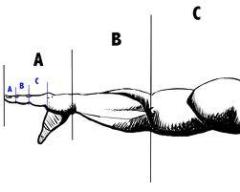The Fibonacci Series
Let’s takes a look at the Fibonacci series, what it is and how it came about, the Fibonacci series relationship to the Golden mean and surprising prevalence in all of nature.
The number sequence known as the Fibonacci series was “discovered” by an Italian mathematician named Leonardo Pisano. The name Fibonacci is short for filius Bonacci which means “the son of Bonaccio” which makes some sense seeing as his father was named Guglielmo Bonacci. Over time Leonardo began to be known just as Fibonacci. Just as in a western culture context a son of John simply became known as Johnson.
Put two rabbits together and before you know it you’ve got rabbits, rabbits everywhere. The issue of rabbits and their almost legendary multiplying capabilities has been known of for centuries. Being a mathematician Fibonacci became interested and set out to investigate how fast rabbits could reproduce under ideal circumstances. The results are now known as the Fibonacci series
When you take into consideration that a pair of rabbits reaches maturity in one month and the gestation period is also one month how many pairs will we have at the end of a year?
Month #0 there is 1 pair,
Month #1 the pair has mated but not yet given birth, so we still have I pair.
Month #2 our original pair has given birth, making 2 pairs.
Month #3 the original pairs births again, the second pair mates but they don’t give birth. Now we have three pair.
Month #4 our original gives birth, the pair born in month 2 gives birth and the pair born in month 3 mate giving us 5 pairs.
In month #5 every pair that was alive two months ago gives birth so now we have 8 pairs of rabbits.
I believe you get the idea but just for fun can you determine how many pairs of rabbits we would have at the end of two or three years? Have you determined from our example how the Fibonacci series flows? Every number in the series is the sum of the two numbers preceding it. It goes like this:
0, 1, 1, 2, 3, 5, 8, 13, 21, 34, 55………… to infinity.
When Fibonacci uncovered the Fibonacci series, I am relatively certain he never knew how this ingenious numbering system occurs literally everywhere. The pattern of florets of a flower, the bracts of a pine cone, or even the scales of a pineapple these numbers are applicable to the growth of every living thing including human beings. For example we have 8 fingers, 5 digits on our hands, 3 bones in each finger, 2 bones in 1 thumb and 1 thumb on each hand. And the ratio between our forearms and our hand is known as the “Golden ratio” or “divine proportion”. The Golden ration is a number approximately 1.618 we know as Phi.
Phi, identified by Euclid two thousand years ago for its role in the construction of the pentagram and the ratio is found throughout nature including the shapes of galaxies containing billions of stars, and yes; even the technical analysis of the financial markets. When we recognize that the ratios of the Fibonacci sequence numbers converge on Phi their importance in how we as traders analyze the markets cannot be understated.
Want to understand trading how to ? Forex Market Preview reveals the secrets you need to be a successful currency trader. Jason Stapleton is a master trader and will help with the trading psychology and ratio analysis that will help make you not only profitable but consistently profitable.


